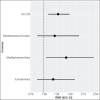The relationship between inflammatory bowel disease and Helicobacter pylori across East Asian, European and Mediterranean countries: a meta-analysis
- PMID: 32879595
- PMCID: PMC7406810
- DOI: 10.20524/aog.2020.0507
The relationship between inflammatory bowel disease and Helicobacter pylori across East Asian, European and Mediterranean countries: a meta-analysis
Abstract
Background: The current literature suggests a protective benefit of Helicobacter pylori (H. pylori) infection against inflammatory bowel disease (IBD). Here we assessed whether this effect varied by IBD subtype-Crohn's disease (CD) or ulcerative colitis (UC)-and geographic region: East Asia, Europe (non-Mediterranean) or Mediterranean region.
Methods: A database search was performed up to July 2019 inclusive for all studies that compared H. pylori infection in IBD patients vs. non-IBD controls. The relative risk (RR) was used to quantify the association between IBD and H. pylori, and the effects were combined across studies using a mixed-effects meta-regression model, which included IBD subtype and geographic region as categorical moderator variables.
Results: Our meta-regression model exhibited moderate heterogeneity (I2=48.74%). Pooled RR depended on both region (P=0.02) and subtype (P<0.001). Pooled RRs were <1 for all subtype and region combinations, indicative of a protective effect of H. pylori against IBD. The pooled RR was 28% (9%, 50%; P=0.001) greater for UC vs. CD and 43% (4%, 96%; P=0.02) greater for Mediterranean countries vs. East Asia. The pooled RR was 18% (-13%, 60%; P=0.48) greater for Europe vs. East Asia and 21% (-13%, 68%; P=0.42) greater for Mediterranean vs. Europe, though these differences were not statistically significant.
Conclusions: The protective effect of H. pylori on IBD varied by both subtype (more protection against CD vs. UC) and region (East Asia more protected than Mediterranean regions). Variation due to these effects could provide insight into IBD etiology.
Keywords: East Asia; Europe; Helicobacter pylori; Mediterranean; inflammatory bowel disease.
Copyright: © Hellenic Society of Gastroenterology.
Conflict of interest statement
Conflict of Interest: None
Figures





References
-
- Burisch J, Munkholm P. The epidemiology of inflammatory bowel disease. Scand J Gastroenterol. 2015;50:942–951. - PubMed
-
- Ng SC, Shi HY, Hamidi N, et al. Worldwide incidence and prevalence of inflammatory bowel disease in the 21st century:a systematic review of population-based studies. Lancet. 2018;390:2769–2778. - PubMed
-
- Kaplan GG. The global burden of IBD:from 2015 to 2025. Nat Rev Gastroenterol Hepatol. 2015;12:720–727. - PubMed
LinkOut - more resources
Full Text Sources
